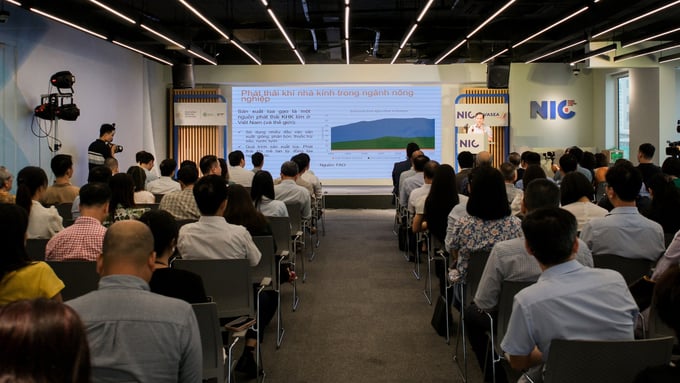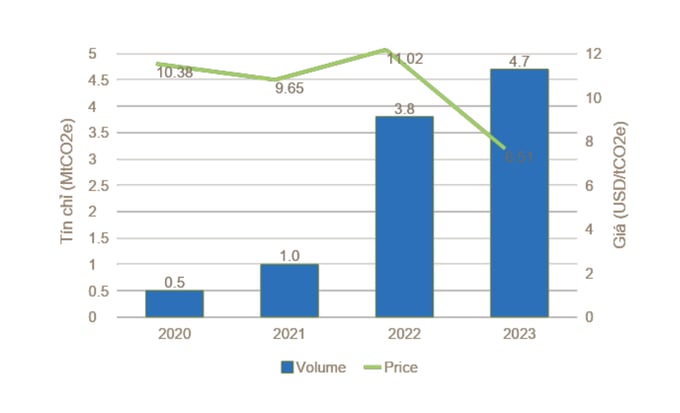June 23, 2025 | 02:20 GMT +7
June 23, 2025 | 02:20 GMT +7
Hotline: 0913.378.918
June 23, 2025 | 02:20 GMT +7
Hotline: 0913.378.918

Workshop on "Promoting green innovation in agriculture through market mechanisms" held at the Vietnam National Innovation Center on September 17. Photo: Quynh Chi.
The National Innovation Center (Ministry of Planning and Investment), in collaboration with the Vietnam-Australia Scholars Association (VASEA), hosted a workshop on September 17 titled “Promoting green innovation in agriculture through market mechanisms.”
Developing a sustainable and environmentally friendly agricultural sector is a priority task within Vietnam’s socio-economic development policy. The workshop, which is based on the “National Strategy for Green Growth from 2021 to 2030, with a vision towards 2050,” emphasized the commitment to supporting Vietnamese businesses in the field of green transformation.
During the workshop, economists, policy experts, and sustainable development specialists from the Australian National University highlighted the opportunities and challenges in promoting low-emission rice production through market mechanisms.
According to Associate Professor Chu Hoang Long, rice producers typically bear the costs associated with reducing greenhouse gas emissions. Consequently, economic compensation is necessary to incentivize emission reduction efforts from rice producers.
“The Monitoring, Reporting, and Verification (MRV) process is crucial for implementing market mechanisms. Multiple production groups have reported adopting efficient input techniques, albeit at higher actual costs,” noted Associate Professor Long.
In support of Associate Professor Long's opinion, expert Nguyen Thi Hai further explained that participating in carbon projects requires farmers to adopt more advanced cultivation techniques compared to their current traditional practices. This transition not only helps reduce methane emissions but also provides additional benefits, such as reduced water usage, lower production costs, and increased yields.
Moreover, farmers committed to low-emission rice production gain access to training programs and resources, which contribute to the long-term sustainability of agricultural land.

Carbon credit transactions from agricultural acitivities experienced a strong increase from 2020 to 2023.
Dr. Hai provided information on the Verified Carbon Standard (VCS) and the Gold Standard to further emphasize the opportunities for accessing the carbon market in rice production.
Both VCS and Gold Standard aim to improve rice production methods and reduce net emissions. These standards encourage farmers to adopt sustainable practices that minimize environmental impact and enhance resilience to climate change.
Notably, VCS-approved activities include alternating wet-dry irrigation methods, mechanized sowing, and utilizing drought-resistant rice varieties to conserve water.
In contrast, the Gold Standard supports alternating wet-dry irrigation and sowing; however, it imposes stricter requirements on the number of irrigation cycles and water withdrawal timing.
Policy expert Do Nam Thang provided deeper insights into the carbon market mechanism. Buyers in this market include agencies, companies, or individuals seeking to offset their emissions, whereas sellers include projects that have demonstrated greenhouse gas reductions and qualify to provide carbon credits to the market.
These stakeholders trade carbon credits on the market, with prices varying based on supply and demand. Prices are typically higher in compliance markets due to regulatory requirements.
Dr. Thang cited the Australian Carbon Credit Units Scheme (ACCUs) as a potential model with elements well-suited to Vietnam’s background.
“The model is highly compatible with Vietnamese farmers and industries, as many aspects of the program are relatively familiar. It also offers flexibility for both smallholder farms and major businesses, allowing all economic participants to engage and benefit,” added Dr. Thang.

The implementation of emission reduction programs in Vietnam requires stable and long-term funding. Photo: Kim Anh.
Experts at the workshop asserted that the successful implementation of emission reduction programs in Vietnam requires stable and long-term funding sources. A potential solution is the introduction of a national carbon tax. Moreover, revenues from the carbon tax can be used to finance greenhouse gas reduction projects.
Additionally, the Vietnamese government can potentially organize emission rights auctions to create a fund that supports emission reduction initiatives and projects.
Regarding mechanisms, Dr. Do Nam Thang suggested stakeholders to enhance feasibility by linking the program with the National Carbon Market, which has an expected establishment date in 2028. Furthermore, an existing agency or organization in Vietnam can manage the program to ensure continuity and effectiveness.
During the panel discussion at the workshop, Dr. Dang Duc Anh, Director of the Central Institute for Economic Management, assessed that pilot models under the One Million Hectares Project have demonstrated significant benefits, particularly in increasing rice yields.
However, the government must create mechanisms for deeper business engagement and establish stronger connections with cooperatives. With current trends, farmers can enjoy a relatively stable income level if the market accepts higher costs, especially within high-end segments with stricter technical standards.
Entrepreneur Nguyen Thi Thanh Thuc concurred and emphasized the need to build a national brand for agricultural products to encourage collaboration between businesses and farmers.
Ms. Thuc highlighted that the Ministry of Agriculture and Rural Development is promoting a shift towards an agricultural economy, which presents a significant economic challenge. She added, “For the rice sector, we need to understand that low-emission rice products are targeted towards high-income consumers who are concerned with environmental and social equity issues.”

Dr. Dang Kim Son discussing market mechanisms for sstainable agricultural production. Photo: Quynh Chi.
Dr. Dang Kim Son, an agricultural economics expert, underscored the crucial role of the government in connecting agricultural markets during the panel discussion. He noted that although social investment in agriculture constitutes only 5% of the total investment capital, its impact is substantial. Additionally, the transition from small-scale production to a green agricultural economy requires active government involvement.
Dr. Son also informed the panel that European countries will begin implementing emission taxes for agriculture starting in 2026. If Vietnamese products are qualified for a “green” certification, they can reduce tax burdens as well as open new branding opportunities for Vietnam’s rice industry.
Dr. Son analyzed, “Vietnam must maintain its competitive advantages to achieve these goals. As a result, complying with international commitments and establishing emission reduction standards are crucial. These standards will serve as a basis for measuring emission reductions from large to small production areas, thereby providing an accurate assessment of Vietnam’s reductions.”
Various sectors will face high carbon taxes from Europe in the near future, which can pose significant challenges for major industries. With Vietnam’s potential for carbon emission reductions, a balanced approach across domestic production sectors is necessary to achieve optimal results.
Translated by Nguyen Hai Long
![Turning wind and rain into action: [9] Digitizing hydrometeorological data in response to climate change](https://t.ex-cdn.com/nongnghiepmoitruong.vn/608w/files/news/2025/06/17/z6704423696987_15fd32ffc26d590d204d520c9dac6786-nongnghiep-165943.jpg)
(VAN) Farmers have begun accessing hydrometeorological applications to adjust their cropping schedules, aiming to ensure productivity and adapt to climate change.
![Turning wind and rain into action: [8] Real-time salinity detection and early warning technology](https://t.ex-cdn.com/nongnghiepmoitruong.vn/608w/files/news/2025/06/17/z6704423696987_15fd32ffc26d590d204d520c9dac6786-nongnghiep-151127.jpg)
(VAN) Thanks to the integration of modern hydrological-hydraulic models, remote sensing technologies, and artificial intelligence, the accuracy of hydrological forecasting has significantly improved.
![Turning wind and rain into action: [7] Early disaster warnings help marine farmers minimize losses](https://t.ex-cdn.com/nongnghiepmoitruong.vn/608w/files/news/2025/06/17/z6704423696987_15fd32ffc26d590d204d520c9dac6786-nongnghiep-142942.jpg)
(VAN) In recent years, thanks to early disaster warnings and forecasting, marine farmers in Khanh Hoa province have been able to reduce risks and losses, thereby improving production efficiency.
![Turning wind and rain into action: [6] ‘Four on-the-spot’ disaster management software](https://t.ex-cdn.com/nongnghiepmoitruong.vn/608w/files/news/2025/06/17/e5a48259d6a262fc3bb3-nongnghiep-183800.jpg)
(VAN) By simply activating the scenario on the disaster management software, the relevant authorities immediately know how many households need to be evacuated, where to evacuate them to, and by what means of transportation…
![Turning wind and rain into action: [5] Hue applies modern technology in disaster forecasting](https://t.ex-cdn.com/nongnghiepmoitruong.vn/608w/files/news/2025/06/17/z6704423696987_15fd32ffc26d590d204d520c9dac6786-nongnghiep-093938.jpg)
(VAN) In Hue city, modern technology has recently been applied in meteorological and hydrological forecasting and warning, helping to reduce the damage caused by natural disasters.

(VAN) A cutting-edge farming technique being implemented on an experimental ranch in Arizona's Sonoran Desert has already saved a billion gallons of water over five years, according to Civil Eats.

(VAN) Poultry and pig production and the environment can be boosted through enhanced water technology, according to new research.